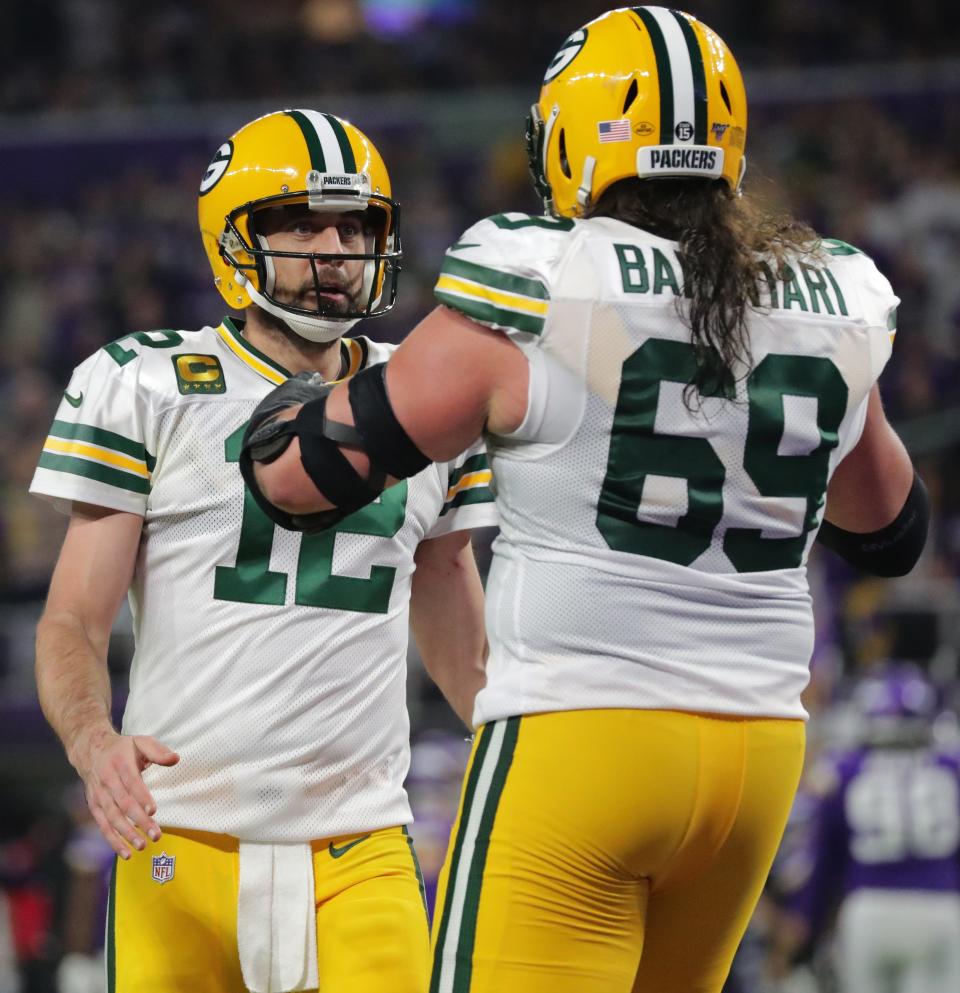Packers lineman David Bakhtiari (and Randall Cobb) vocal about field-turf perils in aftermath of Aaron Rodgers injury
Green Bay Packers offensive lineman David Bakhtiari has been vocal about the dangers of artificial field turf as it relates to injury incidence in the NFL, and he expressed anger on behalf of his former teammate Monday night.
Quarterback Aaron Rodgers, for whom Bakhtiari has blocked since he wad drafted by the Packers in 2013, suffered an apparent Achilles injury on the first drive of his debut with the New York Jets. MetLife Stadium in New Jersey is one of 14 out of 30 NFL stadiums that employs the artificial surface.
Congrats @nfl. How many more players have to get hurt on ARTIFICIAL TURF??! You care more about soccer players than us. You plan to remove all artificial turf for the World Cup coming up. So clearly it’s feasible.
I’m sick of this..Do better!— David Bakhtiari (@DavidBakhtiari) September 12, 2023
"How many more players have to get hurt on ARTIFICIAL TURF??!" Bakhtiari fumed on X/Twitter. "You care more about soccer players than us. You plan to remove all artificial turf for the World Cup coming up. So clearly it's feasible. I'm sick of this..Do better!"
The FIFA World Cup requires natural grass for its competitions, meaning fields in seven U.S. stadiums will convert their fields for the 2026 competition hosted by the United States, Mexico and Canada. That includes Dallas, Los Angeles, Boston, Seattle, Houston, Atlanta and, yes, MetLife Stadium, though the installment is scheduled just a few months before the tournament and won't be a long-term solution in all venues.
This isn't a new issue for Bakhtiari or the National Football League Players Association. Packers players spoke about their preference for natural grass last December.

“You're faster on turf, but you're also more prone to injury,” said then-Packers receiver Allen Lazard, now Rodgers' teammate with the Jets. “Whatever extra speed that you're getting, other players are getting as well. So same thing with grass. You’re getting that speed. They’re getting that speed as well. So it’s not like you're gaining an advantage over your opponent because you both play on the same surface. If anything, it's just you're more likely to get injured, especially going to the ground.”
According to data collected from 2012 to 2018 by the players union, “players have a 28% higher rate of non-contact lower extremity injuries when playing on artificial turf. Of those non-contact injuries, players have a 32% higher rate of non-contact knee injuries on turf and a staggering 69% higher rate of non-contact foot/ankle injuries on turf compared to grass.”
Former Packers offensive lineman J.C. Tretter, who serves as president of the NFLPA, wrote an editorial in April further spotlighting stats illustrating greater risk of lower-extremity injury on synthetic surfaces vs. natural surfaces from games between 2018 and 2021. Tretter said the NFLPA has grown to distrust the NFL on the issue, too, believing the league latched on to an anomalous 2021 season to disregard years of data.
"The credibility the league has with the players on health and safety issues is virtually nonexistent," he wrote. "Instead of following the long-term data (which is clear on this issue), listening to players and making the game safer, the NFL used an outlier year to engage in a PR campaign to convince everyone that the problem doesn’t actually exist. For example, the Tennessee Titans recently announced that they will be changing from a grass field to turf, citing that they believe the change will make the field safer."
Tretter wrote that field surfaces can be tested for hardness using something called the "Clegg" test, and Carolina's field failed the test late in 2022, But even with that knowledge, the league began a game on a concrete-like surface anyway.
"As much as the NFL wants to ignore the grass field issue, the data and their actions will continue to demonstrate their callous hypocrisy," Tretter wrote.
These sentiments were echoed by former Packers receiver Randall Cobb, now with Rodgers in New York, when he was quoted by The Athletic following Rodgers' injury.
"We wanted the NFL to protect the players with grass fields, but the NFL is more worried about making money," Cobb said. "Profit over people, it’s always been the case. I’ve never been a fan of turf. That’s my stance.”
MetLife Stadium requires a surface that can withstand a unique volume of usage as home venue to two NFL teams; the Cowboys and Giants played the Sunday night game at the stadium one night before the Bills-Jets game. Before the 2023 season, the venue installed a new artificial turf system seen as the superior option for reducing injuries.
“...My hope is we can get to a day at some point in the future when we can have a grass field that we’re able to maintain with two different teams and all the other events we have,” Giants president John Mara said at the annual NFL meetings. “I think we can get there at some point, Maybe it’s a hybrid product or something.”
In Green Bay, the Packers use a combination of real Kentucky bluegrass and synthetic fibers. The latter composes about 3% of the field and the synthetic blades are stitched into the sand layer, through the Kentucky bluegrass blades, every three-quarters of an inch.
Kassidy Hill contributed to this story.
This article originally appeared on Milwaukee Journal Sentinel: Packers' David Bakhtiari slams NFL for turf issue after Rodgers hurt

